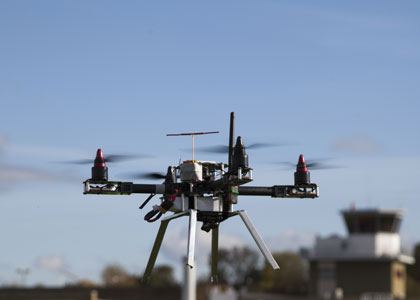
Number plates for drones will improve safety
The University of Southern Denmark and the Danish Transport and Construction Agency are working together towards the effective and safe use of drones - a necessity for supporting the industry and the development of growth potential. Number plates is the first step.
The University of Southern Denmark (SDU) and the Danish Transport and Construction Agency are now joining forces to support and promote the development of technological and infrastructural solutions that will ensure the effective and safe use of drones.
"By entering into this collaboration, the Danish Transport and Construction Agency has the opportunity to draw on SDU's expertise in the development of drones and to try out new technologies. It also means that the Danish Transport and Construction Agency gets a good foundation on which to base upcoming drone regulations," says Per Schmock, Head of Division at the Danish Transport and Construction Agency.
"SDU's UAS centre recognises that a combination of technological improvements and political decisions are required to achieve future growth in the drone industry. Therefore we have entered a collaboration agreement with the Danish Transport and Construction Agency about the development of technical solutions in support of upcoming drone regulations, which can contribute to their knowledge and experience in the area," says Brad Beach, Leader of SDU's drone centre, SDU UAS Center.
Growth potential
The drone industry has been undergoing rapid growth in recent years and according to the European Commission in 2050 the growth will translate into 150,000 jobs and a revenue of 15 billion euros in Europe. If the growth potential is to be realised, there are a number of challenges to be met in order to secure personal safety and privacy.
"At the moment we are seeing a strong growth in the proliferation and possible application of drones. This development greatly challenges the regulations for the use of drones that originate from a time when today's usage of drones was not even dreamt of. Consequently, there is a need to adapt and introduce up-to-date regulations so that new possibilities inherent in drones can be best used while simultaneously ensuring public acceptance of drones," says Per Schmock.
Number plates
An important step is the introduction of drone number plates which will allow the authorities to identify airborne drones as well as to monitor drone activity online. Two different models are being worked on: One is a small GPS that sends its position via the mobile network to a server when the drone is airborne, the other will send direct radio communication to a scanner on the ground.
"If the commercial drone industry is to be a success, it requires the population's confidence in secure and lawful operation. Solutions must be simple, cheap and easy to implement in order to be successful. I think that the drone number plate will live up to all these demands," says Brad Beach.
Test flight
SDU has successfully undertaken the first test flights at HCA Airport in Odense and from the middle of November and for one month thereafter 10 professional drone operators will have their drones fitted with a number plate. Drawing from these experiences, SDU will deliver a report to the Danish Transport and Construction Agency at the end of the year. The report will help to create the basis for forthcoming drone legislation.
"We will see continued growth in the use of drones. With electronic ID/number plates it will be far easier to ensure that drones operating in urban areas are authorised and that they are operating in accordance with regulations," says Per Schmock.
The project builds on a collaboration between UAS Denmark and the Danish Transport and Construction Agency.
For more information contact:
Brad Beach, Center Leader of SDU UAS Center, brbe@mmmi.sdu.dk, 6550 9523
Søren Kragh Pedersen, Press Manager, Danish Transport and Construction Agency, skp@tbst.dk, 4178 0459